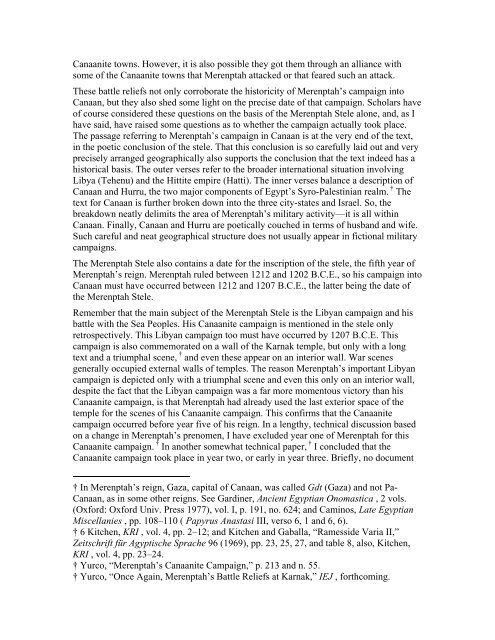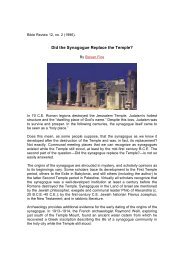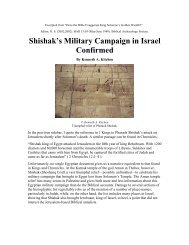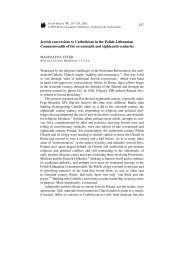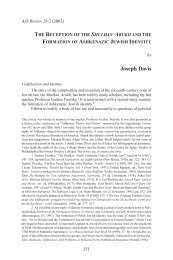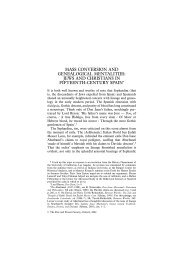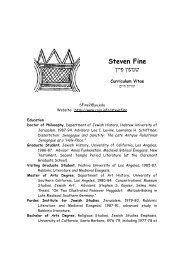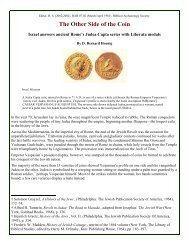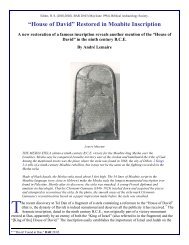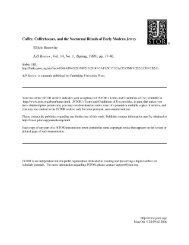3200-Year-Old Picture of Israelites Found in Egypt
3200-Year-Old Picture of Israelites Found in Egypt
3200-Year-Old Picture of Israelites Found in Egypt
You also want an ePaper? Increase the reach of your titles
YUMPU automatically turns print PDFs into web optimized ePapers that Google loves.
Canaanite towns. However, it is also possible they got them through an alliance with<br />
some <strong>of</strong> the Canaanite towns that Merenptah attacked or that feared such an attack.<br />
These battle reliefs not only corroborate the historicity <strong>of</strong> Merenptah’s campaign <strong>in</strong>to<br />
Canaan, but they also shed some light on the precise date <strong>of</strong> that campaign. Scholars have<br />
<strong>of</strong> course considered these questions on the basis <strong>of</strong> the Merenptah Stele alone, and, as I<br />
have said, have raised some questions as to whether the campaign actually took place.<br />
The passage referr<strong>in</strong>g to Merenptah’s campaign <strong>in</strong> Canaan is at the very end <strong>of</strong> the text,<br />
<strong>in</strong> the poetic conclusion <strong>of</strong> the stele. That this conclusion is so carefully laid out and very<br />
precisely arranged geographically also supports the conclusion that the text <strong>in</strong>deed has a<br />
historical basis. The outer verses refer to the broader <strong>in</strong>ternational situation <strong>in</strong>volv<strong>in</strong>g<br />
Libya (Tehenu) and the Hittite empire (Hatti). The <strong>in</strong>ner verses balance a description <strong>of</strong><br />
Canaan and Hurru, the two major components <strong>of</strong> <strong>Egypt</strong>’s Syro-Palest<strong>in</strong>ian realm. † The<br />
text for Canaan is further broken down <strong>in</strong>to the three city-states and Israel. So, the<br />
breakdown neatly delimits the area <strong>of</strong> Merenptah’s military activity—it is all with<strong>in</strong><br />
Canaan. F<strong>in</strong>ally, Canaan and Hurru are poetically couched <strong>in</strong> terms <strong>of</strong> husband and wife.<br />
Such careful and neat geographical structure does not usually appear <strong>in</strong> fictional military<br />
campaigns.<br />
The Merenptah Stele also conta<strong>in</strong>s a date for the <strong>in</strong>scription <strong>of</strong> the stele, the fifth year <strong>of</strong><br />
Merenptah’s reign. Merenptah ruled between 1212 and 1202 B.C.E., so his campaign <strong>in</strong>to<br />
Canaan must have occurred between 1212 and 1207 B.C.E., the latter be<strong>in</strong>g the date <strong>of</strong><br />
the Merenptah Stele.<br />
Remember that the ma<strong>in</strong> subject <strong>of</strong> the Merenptah Stele is the Libyan campaign and his<br />
battle with the Sea Peoples. His Canaanite campaign is mentioned <strong>in</strong> the stele only<br />
retrospectively. This Libyan campaign too must have occurred by 1207 B.C.E. This<br />
campaign is also commemorated on a wall <strong>of</strong> the Karnak temple, but only with a long<br />
text and a triumphal scene, † and even these appear on an <strong>in</strong>terior wall. War scenes<br />
generally occupied external walls <strong>of</strong> temples. The reason Merenptah’s important Libyan<br />
campaign is depicted only with a triumphal scene and even this only on an <strong>in</strong>terior wall,<br />
despite the fact that the Libyan campaign was a far more momentous victory than his<br />
Canaanite campaign, is that Merenptah had already used the last exterior space <strong>of</strong> the<br />
temple for the scenes <strong>of</strong> his Canaanite campaign. This confirms that the Canaanite<br />
campaign occurred before year five <strong>of</strong> his reign. In a lengthy, technical discussion based<br />
on a change <strong>in</strong> Merenptah’s prenomen, I have excluded year one <strong>of</strong> Merenptah for this<br />
Canaanite campaign. † In another somewhat technical paper, † I concluded that the<br />
Canaanite campaign took place <strong>in</strong> year two, or early <strong>in</strong> year three. Briefly, no document<br />
† In Merenptah’s reign, Gaza, capital <strong>of</strong> Canaan, was called Gdt (Gaza) and not Pa-<br />
Canaan, as <strong>in</strong> some other reigns. See Gard<strong>in</strong>er, Ancient <strong>Egypt</strong>ian Onomastica , 2 vols.<br />
(Oxford: Oxford Univ. Press 1977), vol. I, p. 191, no. 624; and Cam<strong>in</strong>os, Late <strong>Egypt</strong>ian<br />
Miscellanies , pp. 108–110 ( Papyrus Anastasi III, verso 6, 1 and 6, 6).<br />
† 6 Kitchen, KRI , vol. 4, pp. 2–12; and Kitchen and Gaballa, “Ramesside Varia II,”<br />
Zeitschrift für Agyptische Sprache 96 (1969), pp. 23, 25, 27, and table 8, also, Kitchen,<br />
KRI , vol. 4, pp. 23–24.<br />
† Yurco, “Merenptah’s Canaanite Campaign,” p. 213 and n. 55.<br />
† Yurco, “Once Aga<strong>in</strong>, Merenptah’s Battle Reliefs at Karnak,” IEJ , forthcom<strong>in</strong>g.


